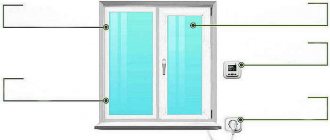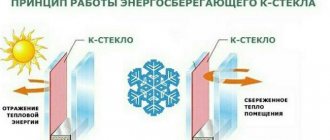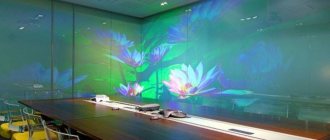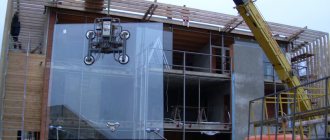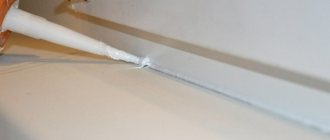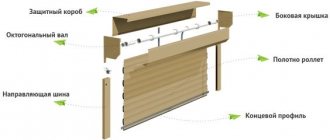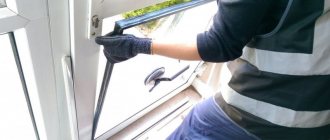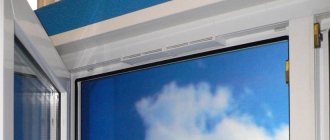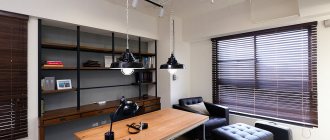Smart glass is not a new topic in the window market. The use of glass with switchable transparency is becoming popular in the architectural environment and reflects current trends in the development of interactive devices. This state-of-the-art design element is technologically advanced, and what seemed impossible just a few years ago is now becoming a reality. At the Glasstec 2016 exhibition (Dusseldorf, Germany), manufacturing companies presented innovations in the production and use of Smart glass, says the OKNA MEDIA portal.
What is smart glass?
Smart glass is an innovative material with variable transparency function .
Between two sheets of transparent glass there is a liquid crystal film. A low voltage electric current is supplied to it. When turned off, without exposure to current, the liquid crystals are arranged randomly and scatter light. The glass in this case is frosted and opaque.
When the mode is on, the arrangement of liquid crystals is ordered, glass (for example, for partitions) becomes transparent. In both cases, the amount of light transmitted does not change. Unlike blinds or shade curtains, frosted glass does not darken the room.
The creator of smart glass is engineer Steve Abadie. He got the idea back in the 70s of the last century. However, the technology of those years did not allow Abadi’s plan to be realized. The first smart glass, LC Glass, was introduced to customers in 1984. Later, S. Abadi founded the Innovative Glass Corporation. In 2003, it released smart glass under the E-Glass brand.
Smart glass appeared in Russia in 2010. Since then, it has been rapidly conquering the market and is increasingly used not only in offices, medical institutions and administrative premises, but also for glazing house windows and in interior design.
NAYADA solutions with Smart Glass technology
Our company produces and sells “smart” glass not just as a separate product. We integrate them into designs for space planning. The range includes all-glass and combined partitions, as well as doors of various types. We can carry out an original project, for example, curved glass with electrochromic film.
Implementation of projects with Smart glass in a ready-made base takes a minimum of time - standard sizes are suitable for most offices. Choose stationary systems for any task:
- Standart - reliable aluminum frames finished with veneer or durable powder coating in any shade of the RAL palette;
- Intero 400 and Intero 700 are elegant, visually lightweight panels without visible fasteners with sound insulation up to 47 dB;
- Twin - individual panels are connected by a barely noticeable polycarbonate profile, it looks like a solid wall with noise insulation of 46 dB;
- Quadro - thin decorative strips create a complex cut pattern on the surface, creating walls with an extraordinary design.
We can integrate suitable doors into any system - swing or sliding Slim, all-glass double Intero or soundproof Magic.
With NAYADA smart partitions and doors, your office interior will become aesthetically pleasing and functional.
Advantages and disadvantages
The material has both advantages and disadvantages.
Advantages:
- multifunctionality. The material functions as simple glass, a visual obstruction and a projection screen;
- strength;
- a modern alternative to curtains and blinds;
- a wide range of smart film colors, which allows you to use it for a unique design;
- controlled by low voltage supply;
- energy saving function;
- soundproofing;
- UV protection;
- wide scope of application.
Modern types of material based on suspended particles have a high degree of transparency, without clouding. If earlier smart film had to be laminated into triplex, then modern film can simply be glued.
Flaws:
- price;
- the need for electrical voltage;
- quite high energy consumption.
However, the cost of the structures is offset by the energy-saving and protective function of the material. Smart glass protects from solar radiation. And the savings on air conditioning cover the costs of glazing. This is especially true for southern, sunny regions.
Developers are trying to reduce energy consumption. Thus, a student from the Netherlands patented a technology - glass itself produces energy from sunlight and, using it, changes transparency. Russian and French scientists have improved the technology - glass, in addition to providing itself with energy, creates additional external power and can supply energy to other devices.
Certain types of smart glass have their own disadvantages. For example, material with suspended particles requires special coatings to block ultraviolet light.
The disadvantage of electrochromic material is the low rate of transition from one state to another. The darkening time is up to several minutes.
Structure of smart film
Protective outer layers (thickness ~175 µm):
- ITO - film of indium and tin oxides
- PET – polyethylene terephthalate film
- With transparent conductive coating (on the inside)
The inner layer is liquid crystal drops filled with polymer (thickness ~20 µm).
Film thickness: about 400 microns
Basic operating principles
The unique properties of smart glass depend on its special design. Between two transparent sheets there is a film with liquid crystals. They are the ones who impart beneficial properties to the material. When electricity is supplied, an electromagnetic field is created. Under its influence, the arrangement of the crystals changes, from chaotic to orderly. This affects the light transmission properties of the glass, it becomes transparent. Light passes through the film without encountering obstacles in the form of piles of crystals. In its normal state, the material is matte.
The current strength can be adjusted using a special device. If the voltage is low, then not all liquid crystals are ordered. The product becomes only partially transparent. The higher the voltage, the greater the level of transparency.
Versatility
You can use smart partitions for business or to delimit space in an apartment: you don’t have to build a wall or install bulky structures. It is enough to install glass that can become dark when you need to remove something from your eyes, or, on the contrary, become transparent if you need to visually enlarge the space.
This solution is perfect for skylights. You don't have to think about how to darken them, insulate them or isolate sound, since the film copes with all these tasks perfectly.
Production technologies
Smart glass is a complex structure consisting of three main layers:
- Sheet of transparent glass.
- Double layer film. Liquid crystals are placed between its layers.
- Second sheet of transparent glass.
Common manufacturing technologies depending on the type of film:
- EVA - ethylene vinyl acetate film;
- TPU - thermoplastic polyurethane;
- PVB - polyvinyl butyral film.
Polymer liquid crystal devices (LCD)
The liquid crystals in these devices are broken down into their constituents and then solidified. At the moment of transition from a liquid to a solid state, the crystals become incompatible with the polymer and create inclusions (drops) in it. The conditions under which fixation occurs affect the size of the inclusions, which affects the properties of the smart glass.
A mixture of polymer and liquid crystals is placed between two sheets of plastic or glass. A thin layer of transparent electrically conductive material is applied. It is responsible for the supply of voltage. Electrodes in contact with the conductive layer are made of copper foil. When voltage is applied, the electromagnetic field causes the crystals to line up in an orderly manner. Light enters through droplets and the material becomes transparent.
By using additional layers or using dye, you can control the amount of heat and light passing through the glass. Fire and anti-radiation options used in special devices are possible.
Suspended Particle Devices (SPD)
Between two sheets of transparent glass there is a film of rod-shaped particles suspended in a liquid. Without electrical voltage, the particles are in a chaotic state and absorb light. In this case, the glass has a gray, black or dark blue tint. When current is applied, the suspended particles are arranged in an orderly manner, and the glass becomes transparent.
The transition happens instantly. To maintain a transparent state, a small but constant current is required. The peculiarity of the material is that it is optically transparent in any state.
Electrochromic Devices (ECD)
In electrochromic (electrochemical) devices, the variable layer is a sputtering of lithium ions. Applying voltage regulates transparency. The amount of light transmitted can be controlled. The state of the material changes between transparent, translucent and colored. In the tinted state, shades range from the most saturated to barely noticeable.
Applying voltage is only needed to change transparency. No power is required to maintain the state. The darkening starts from the periphery and ends in the center. It takes up to several minutes to completely tint a large area of glass.
How Smart Glass Technology Works
Smart Glass is glass that changes transparency under the influence of electricity. The glass filling in the door or partition instantly responds to commands. After pressing a button on the remote control, the office turns into a private zone or, conversely, becomes visible. The transformation takes less than a second.
You can change the transparency using an electrochromic LCD film, which is attached to the surface of the glass or between two glasses. Without electricity, microcrystals are arranged in a chaotic manner, so by default, “smart” glass tinting is matte. When voltage is applied, the crystals line up one after another and make the film transparent.
In essence, dimmable glass is an electrical appliance. And completely safe. The glazing around the film does not conduct current, as it is a dielectric. The voltage is minimal - only 15 V. No wires are visible. They are hidden in the clips and profile frames of partitions or in door hinges, so everything is aesthetically pleasing and neat.
Additional features of smart glass
Smart glass has a number of additional properties:
- The material can be not only smart, but also durable. For this purpose, reservation technology is used. A special film is glued over the structure, which prevents the glass from cracking and scattering. This allows it to be used in crowded places.
- The product can be made colored by gluing additional film.
- Sandblasting allows you to decorate glass. Such options are used in room partitions, in cafes, restaurants, where they look very impressive.
- You can cut any holes in the products and give the glass any shape.
Characteristics of Saint Gobain glass
| Characteristic* | Single layer construction, 11mm | Standard composition, 12mm | Extra matte construction, 28mm | |||
| ON | OFF | ON | OFF | ON | OFF | |
| Composition | 11mm, single layer | Double-glazed window: 6mm smart glass, 12mm air | argon 15mm, smart glass | |||
| Light transmission, LT | 77% | 76% | 53% | 54% | 62% | 63% |
| Light reflection, LR | 19% | 18% | 20% | 20% | 21% | 21% |
| Thermal conductivity coefficient, SF** | 63% | 64% | 41% | 41% | 46% | 46% |
| Heat loss coefficient, U*** | 5.6÷5.8 W/m2C° | 1.6 W/m2C° | 1.1 W/m2C° | |||
| Haze, H | <7,5% | >90% | <8.5% | >90% | <8.4% | >90% |
*The error of the given values does not exceed +/- 2%
**Thermal conductivity coefficient shows the amount of solar energy (in percent) passing through the structure. The lower the coefficient, the greater the protection from sunlight.
***The coefficient characterizes how well the structure prevents heat loss. Unit: W/m2C°
Scope of application
Initially, smart glass was used only in offices for zoning space. Over time, technology has become more accessible, and the cost of products has become lower. Smart glass has begun to be widely used in residential areas.
There are 2 main areas of use in buildings:
- Creation of internal partitions and design elements.
- External glazing.
Partitions allow you to zone a large space, creating separate, relatively isolated places. This feature is used in offices to demarcate places for employees.
Variable transparency allows you to achieve the effect of a private zone. The ability of smart glass to absorb sound makes meeting rooms not only visually inaccessible, but also protected from casual listeners. When privacy is no longer needed, the glass can be made transparent again.
The advantage of smart partitions is that they do not visually clutter up the area, allowing sufficient light to pass through.
The ability to create separate zones has found application in a wide variety of industries:
- Cafes and restaurants . With the help of partitions, a comfortable atmosphere is achieved where visitors can quietly dine and relax without prying eyes.
- Banks . When serving certain categories of clients or performing banking operations, the glass is darkened or made matte. In addition, the increased strength of the material makes it safe for the waiting room.
- Museums, art galleries, exhibition halls . The property of the material to absorb harmful radiation has found application in such institutions. The correctly chosen degree of tinting allows visitors to freely admire masterpieces of painting or valuable exhibits.
- Medical institutions - massage rooms, dressing rooms and other premises. Adjustable transparency of the material makes it possible to create comfortable conditions for patients in which no one will see them during medical procedures.
- Shopping and entertainment centers . Some shopping centers being built prefer smart glass glazing. Despite the high price, owners see the benefit in subsequent savings on energy saving and air conditioning. The aesthetic appeal of the building increases. In addition, the material is more durable than regular glass, so it will have to be replaced less often.
- Beauty salons providing cosmetology, massage and other services also zone the space using smart glass.
- Residential areas - here smart glass is used to make bathroom screens and shower enclosures.
- Showcases . Reputable trade organizations use the properties of smart glass to create smart storefronts facing the street. Potential buyers can watch an advertising video or product presentation. If it is necessary to demonstrate samples displayed in a display case, the glass is made transparent.
- Automotive industry . It is used for hatches and rear-view mirrors. In expensive premium cars, unique roofs are made from a material with variable transparency. This roof can be controlled from the interior. Electrically tinted glass can be used for side windows. The tint level, adjustable from the interior, allows you to make the windows transparent while driving, but while parking, create a private zone from the interior. Also, partitions between the driver and passenger seats are made from smart glass.
- Balconies and loggias . Smart glass used for glazing windows, balconies and loggias is an alternative to outdated curtains and blinds. Large sizes and the ability to create various shapes allow the material to be used for French and panoramic windows. One of the advantages is the ability to protect the room from ultraviolet radiation, keep it warm in winter and cool in summer. In addition, in an opaque state they protect the interior space of the room from prying eyes.
Winter gardens and greenhouses . The energy-saving ability will protect the plants from hypothermia, and the darkening will prevent too intense sun from burning the leaves and flowers.- Aircraft manufacturing . Some aircraft models are equipped with windows with smart glass, which does not transmit UV radiation and reduces maintenance costs. service.
- Entrance groups, facades . During the construction of houses, smart glass is used for glazing entrance areas, entrances, and facade windows.
- Anti-aircraft lights . Using smart glass for overhead glazing is a great solution for large spaces.
- Fencing in swimming pools. Partitions are made from smart glass, thanks to which private areas are created.
- Decor . Interior designers are increasingly turning to this material when decorating interior doors and creating original design solutions.
- Rear projection screens . The image projected onto the panel will look like a high-quality picture on the back side.
Development prospects
Smart glass is gradually gaining popularity and analysts say that this will continue in the near future. There have already been expert estimates claiming that glass with variable transparency reduces electricity consumption. It allows you to reduce the cost of lighting and air conditioning, and save on advertising screens.
Now smart glass is installed in large office buildings, luxury cars, and expensive country cottages. In the future, its production will become widespread, the price will drop, and windows with adjustable transparency will become available to everyone.
Additional features
In addition to adjustable transparency, glass can perform the following functions:
- Monochrome white can be used as a presentation screen;
- Colored smart glass will decorate your interior;
- The use of LEDs will turn the wall of a building into an advertising screen;
- Lithium films absorb ultraviolet radiation.
Smart glass are multifunctional products, the scope of which will only expand.
Price
The price of smart glass depends on the manufacturer, type of material, thickness, and design features.
- Smart Optimal 4+smart+4 mm with variable transparency, width up to 1800 mm without joint of films, will cost from 23,000 rubles per 1 sq. m.
- Smart Premium glass with the same parameters costs from 29,000 rubles per 1 sq. m. m.
- The price increases with the addition of useful properties and complication of the design.
- Smart Optimal 4+smart+4 mm, hardened, will cost from 25,000 rubles per 1 sq. m.
- Smart Premium hardened - from 31,000 rubles per 1 sq. m.
- The average cost of electrochromic glass is from 32,000 rubles per 1 sq. m.;
- Smart film on glass (with the function of switching between transparent and matte mode), depending on the degree of transparency, costs from 29,000 rubles. for 1 sq. m..
- Control unit for smart glass (transformer), designed for an area of up to 15 square meters. m., in a plastic case, costs from 1900 rubles. In an aluminum case – from 4000 rubles.
Where Smart Glass Technology Is Most Effective
Electrochromic glass is an excellent option for zoning any modern office. During normal times, his space is free and bright. If it is necessary to conduct confidential negotiations, the walls are made blank, turning the open space into a secluded area.
In banks and vaults, double-glazed windows can be given bullet-resistant properties.
Partitions with variable transparency glazing can be used as original advertising stands. In tandem with a projector, the matte surface will act as a screen during presentations.
Frame
In addition to the usual purposes (holding glass, thermal insulation and airtightness), the window frame of variable haze serves as a place where the wires that supply electricity to the glass are hidden. In addition, the frame also hides unsightly busbars (places where wires are connected directly to the glass and films in it).
Frame materials can be any: aluminum profiles, natural wood, plastic, steel and so on.
If the window has opening sashes (this always applies to doors), then cable channels are used to pass the wire from the fixed part to the opening part. As a rule, they are hidden - that is, they are not visible when the part is closed (“laid” in a fixed or movable frame). Cable channels are needed to protect the wire from chafing during regular opening and movement.
Glass transparency control
The control scheme for a window or partition with variable haze can be very diverse. You can switch the transparency of the entire structure simultaneously or control its individual parts.
To supply power to the film, a power supply is used that creates an operating voltage of 110V AC. It is hidden, as a rule, in the ceiling space, in technical hatches or in the electrical control room.
The frosting can be turned on and off by a switch in the frame, on the wall (next to the window or in a completely different place), by a light or motion sensor, by a remote control - or by several of these devices at once.
Previous: All glass smart partitions
DIY installation of an electrochromic window with smart glass
You can make good quality smart glass with your own hands only if you strictly follow the steps of gluing the electrochromic film. They consist of:
- cleaning the glass surface from contaminants such as dust, grease stains;
- removing the protective coating and gluing the film;
- removing formed air bubbles with a rubber roller;
- connecting electrical wires to contacts;
- removing the top protective layer using tape;
- silicone contact treatment and testing;
- hiding contacts behind a metal or plastic strip.
Return to content
Production of translucent structures to order
Modern technologies and high-precision European equipment make it possible to produce impact-resistant materials that are resistant to atmospheric influences and mechanical damage.
Based on the technologies we introduce, we develop and create the following glass products:
- façade glazing elements;
- windows and stained glass;
- office and interior partitions;
- meeting and VIP rooms;
- internal doors, fittings;
- wall glazing;
- suspended glass ceilings;
- exclusive glass products with the integration of other materials according to individual sketches;
- baths and sinks, showers, interior elements of spa areas and swimming pools;
- tables and aprons for the kitchen (thrown off);
- designer heated towel rails;
- floors, stairs, stair railings;
- visors;
We are ready to work from your sketches or help you develop a project from scratch, based on your requirements for the product.
For any questions, call us or come to our office in Moscow. Contact information is provided in the “Contacts” section.

